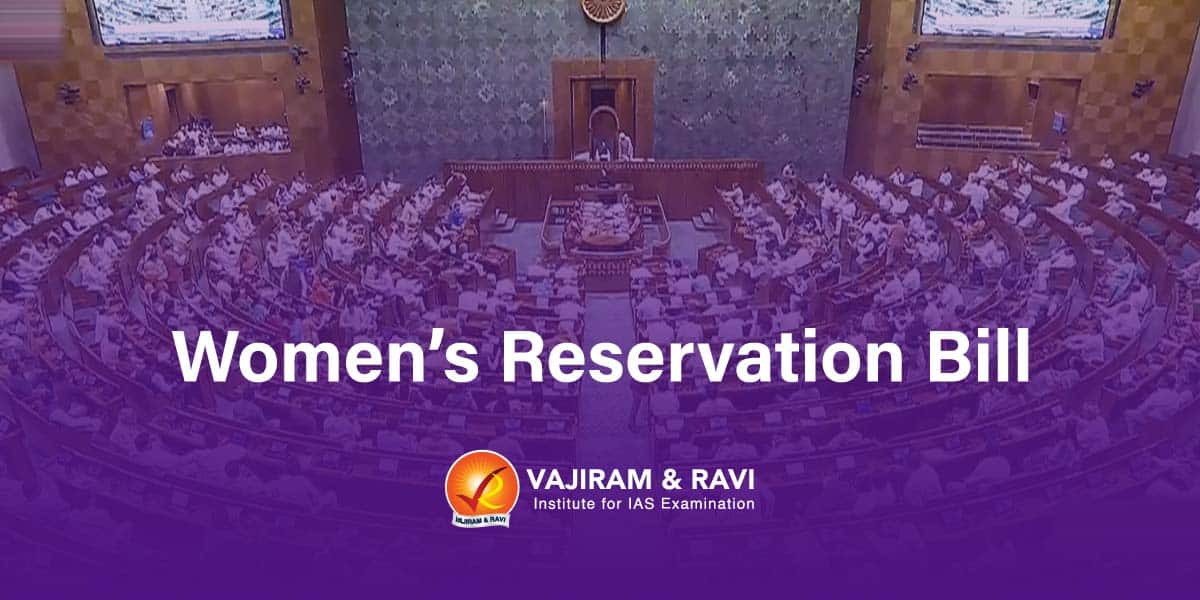Women Reservation Bill: In India, women have made significant achievements in various aspects of life, but there has yet to be substantial progress in political empowerment. The concept of women’s empowerment has lost its weight since the freedom movement. There was a need for special political interventions to ensure equal representation of women in Indian politics, as female representatives felt marginalised. Many women politicians are ineffective minority members, while male politicians dominate party functioning. Interventions like the Women Reservation Bill are necessary to address socio-political barriers that hinder women’s equal representation in the Indian socio-political system.
What is the Women Reservation Bill 2023?
Recently, the Women’s Reservation Bill has been tabled in Lok Sabha as the Constitution (One Hundred and Twenty-Eighth Amendment) Bill. In the Lok Sabha and State Legislative Assemblies, women would receive 33% of the seats under the introduced legislation.
- Articles to be amended: To achieve the goal of women’s reservation, the Bill proposed Amendments to the Constitutional provisions with respect to the NCT of Delhi
- Article 239AA (Special provisions with respect to Delhi),
- New Articles to be inserted: The Women’s Reservation Bill also introduced three new articles, namely Articles 330A, 332A, and 334A.
- The Articles 330A and 332A newly proposed articles want to establish women’s reservation in the Lok Sabha and state legislative assemblies.
- Article 334a included a sunset provision that would gradually end this affirmative action policy after 15 years.
- Horizontal women’s reservation: It is noteworthy that the bill included provisions for horizontal reservation that cut across different quota categories.
- Particularly, women from the Scheduled Caste (SCs) and Scheduled Tribes(STs) are proposed to have one-third of the seats allocated for SCs and STs in the Lok Sabha and legislative assemblies.
- These efforts are aimed at increasing women’s participation in the legislative process, even among groups that have historically been underrepresented.
- Rotation of seats: The designated seats for female lawmakers may be distributed by rotation to various constituencies within a state or union territory.
- Majority required: The Women Reservation Bill would require a special majority of the Parliament and ratification by half of the states. That is a two-thirds majority in both the Houses of Parliament and the approval from at least 50% of states.
- Earliest implementation: However, the earliest moment when one-third of the seats in the Lok Sabha is likely to be occupied by women in 2029
- This is because the Bill says that the “provisions relating to the reservation of seats for women shall come into effect after an exercise of delimitation is undertaken for this purpose after the relevant figures for the first census taken after (the Bill is passed) have been published.”
- This provision of the fresh census and delimitation exercise was not part of the Women’s Reservation Bill passed by the Rajya Sabha in 2010.
Other Constitutional Amendments Needed to Operationalise the Scheme of Women Reservation
Article 82 and Article 170(3) of the Constitution would need to be changed in order to implement delimitation, which is a requirement for the implementation of reservations.
- Article 82 has provisions for the readjustment of constituencies (number and boundaries) of both the Lok Sabha and state Assemblies after each Census.
- Similarly, Article 170(3) deals with the composition of the state Legislative Assemblies.
Women’s Reservation in Panchayats
Article 243D of the Constitution has a provision for the reservation of seats for SCs, STs, and women in Panchayats.
- It also says that nothing in this part shall prevent the legislature of a state from making any provision for the reservation of seats in any Panchayat or offices of Chairpersons in the Panchayats at any level in favour of the backward classes of citizens.
- According to the provisions of Article 243D, women are required to hold no less than one-third of the seats reserved for SCs and STs.
History of Women Reservation Bill
The Women’s Reservation Bill had been introduced in Parliament several times but had not yet been passed into law. Political debates and delays have hindered its progress.
- 1996: The first iteration of the Women’s Reservation Bill was presented to the Lok Sabha as the 81st Constitutional Amendment Bill in September 1996.
- The Bill was referred to a Joint Parliamentary Committee headed by Geeta Mukherjee after the House rejected it, and the committee’s report was presented to Lok Sabha in December 1996. With the Lok Sabha’s dissolution, the bill, however, became lapsed.
- 1998: The bill was reintroduced in the 12th Lok Sabha in 1998, however, the bill lapsed because it did not receive adequate support.
- It was reintroduced three more times in 1999, 2002, and 2003. The bill did not win a majority of votes despite having support from major political parties.
- 2008: The bill was introduced in the Rajya Sabha again in 2008. It was approved with 186 votes to one. However, it was never brought up for discussion in the Lok Sabha and became inoperative upon the dissolution of the 15th Lok Sabha.
- The Parliament’s inability to pass this Bill was due to several factors, primarily stemming from societal attitudes that don’t recognise women as leaders and the belief that women are hesitant to run alongside male candidates.
Significance of Women’s Reservation
The need for affirmative action to improve the status of women in Indian society is one of the main arguments in favour of the bill.
- Skewed gender representation in legislation: According to statistics released by the Union government, women hold only 14.94% of seats in the Lok Sabha and 14.05% of seats in the Rajya Sabha.
- The progress of women’s representation in the Lok Sabha since Independence has been exceedingly slow.
- In the Lok Sabha of 1952, women accounted for a mere 4.4%, and this figure has only marginally increased to 14.94% following the 2019 Lok Sabha elections.
- Many state assemblies have less than 10% women as members.
- Socio-economic significance: Another important claim is that in order to address problems like the high rate of crimes against women, the low participation of women in the workforce, poor nutrition levels, and a skewed sex ratio, women must be represented in the decision-making process.
- Women’s issues are thought to be discussed more effectively in Parliament if there is more women’s representation.
- India comes in at number 127 out of 146 nations in the Global Gender Gap Index, 2023.
- Closing the gender gap in political empowerment would take another 162 years if the report’s rate of progress is followed.
Concerns in the Women Reservation Bill
One of the main concerns of the bill is that women do not form a homogeneous group like a caste would.
- Reserving seats for women would go against the Constitution’s guarantee of equality, according to another argument. Those who support this position claim that if a reservation were implemented, women would not be able to compete on their own merits.
- Concerns About Perpetuating Gender Disparities: This approach would uphold the existing gender disparities, as it might suggest that women are not being judged based on their qualifications.
- Diverting Attention from Crucial Electoral Reforms: This strategy shifts the focus away from more significant electoral reform matters, such as the criminalisation of politics and the state of inner-party democracy.
- Restricts Voter Choice: Reserving parliamentary seats for women restricts voter choice. Some experts suggest alternatives like party reservations.
- Rotating reserved constituencies in each election might reduce an MP’s incentive to work for their constituency.
- Regarding the participation of women in the Rajya Sabha and important Committees, this Bill is entirely silent.
- Many contend that the current election process for the upper house prevents the possibility of reserving seats in the Rajya Sabha.
Women’s Representation in Other Countries
According to the Inter-Parliamentary Union Report, 2019, the African nation of Rwanda came out on top in the assembly’s long-term portrayal with 61.3%, followed by Cuba with 53.2%.
Nepal held the 36th position in South Asia with 32.7%. The unfortunate fact is that India came in at 149th with 14.4% portrayals, in stark contrast to Pakistan and Bangladesh.
- Party line reservation: Countries like France, Korea, and Nepal, among others, have passed quotas as high as 50% of the candidate list.
- Countries with party quota laws include Argentina, Mexico, and Costa Rica, which also have over 36% female representation in their national legislatures.
- Through voluntary (non-legislated) quotas by political parties, nations like South Africa, Sweden, and Germany have attained comparable levels of female representation.
- With 44.8% of its current National Assembly made up of women, South Africa is a great case study.
| Country | % of elected women | Country | % of elected women |
| Sweden | 46% | Canada | 31% |
| Norway | 46% | UK House of Representatives | 29% |
| South Africa | 45% | US Senate | 25% |
| Australia | 38% | Bangladesh | 21% |
| France | 38% | Brazil | 18% |
| Germany | 35% | Japan | 10% |
| UK House of Commons | 35% | – | – |
The Bill’s empowerment of women will contribute to the nation’s overall development, especially for women, and will help to address the intertwined socioeconomic and political inequality. It is being shown in women’s reservation in Panchayats where one-third of the seats in direct panchayat elections are reserved for women as per the 73rd Constitutional Amendment Act of 1992.
Women’s deliberate exclusion from political participation is unacceptable and a violation of their democratic and constitutional rights, given the systematic undervaluation of their labour in the socioeconomic sphere. Therefore, it is essential for the government to take proactive affirmative action. Although reservation alone cannot completely eradicate India’s deeply ingrained gender bias, it is a vital measure to instigate change and ensure equality.
Last updated on April, 2025
→ UPSC Notification 2025 was released on 22nd January 2025.
→ The UPSC Vacancy 2025 were released 1129, out of which 979 were for UPSC CSE and remaining 150 are for UPSC IFoS.
→ UPSC Admit Card 2025 is expected to release in first week of May for CSE Prelims Exam 2025.
→ The UPSC Prelims 2025 is scheduled to be conducted on 25th May 2025 and UPSC Mains 2025 will be conducted on 22nd August 2025.
→ Apply once through it and aspirants can apply for various government exams conducted by UPSC.
→ The UPSC Selection Process is of 3 stages-Prelims, Mains and Interview.
→ UPSC Result 2024 is released with latest UPSC Marksheet 2024. Check Now!
→ UPSC Toppers List 2024 is released now. Shakti Dubey is UPSC AIR 1 2024 Topper.
→ Also check Best IAS Coaching in Delhi
Tags: quest women reservation bill
















